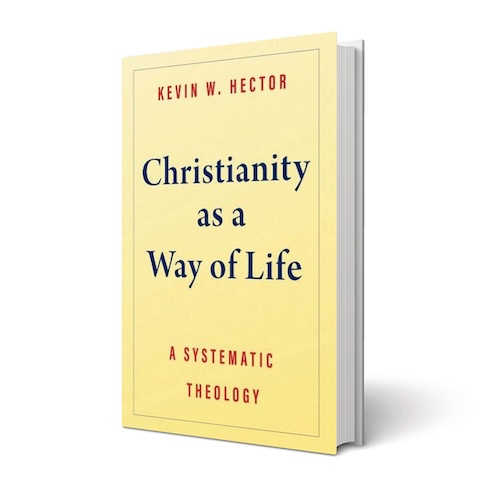In the second-century text known as The Didache or The Lord’s Teaching Through the Twelve Apostles to the Nations, Christianity is presented as one of “two ways, one of life and one of death.” The two ways are distinguished primarily by love and action. The way of life is characterized by the two great love commandments (love God and love neighbor) and ways in which these loves are to be actualized: through the Golden Rule and by obeying commands to “bless those who curse you, and pray for your enemies, and fast for those who persecute you.” Early Christians were also known simply as followers of “The Way,” echoing the stark presentation of apostolic teaching concerning the narrow way “that leads to life” (Matt. 7:14).
Christianity is more than just a way of life. But it is not less. A preoccupation with precise doctrine can offer stumbling blocks to remembering this.

By Kevin W. Hector
(Yale, 2023)
Kevin W. Hector’s Christianity as a Way of Life presents the Christian faith in these kinds of terms, emphasizing practice, social flourishing, and spiritual formation as defining features of this ancient faith. The postliberal theological movement is now entering its fifth decade, and Hector’s work can be understood as standing within that tradition, which downplays metaphysics and traditional scholastic doctrinal formulations in favor of narrative expressions of theological truths. Hector’s distinctive approach could be considered a kind of postliberal orthodoxy, in that he does affirm the significance of right understanding and belief for achieving wisdom, which leads to right living. Hector’s method, however, tends to deemphasize the significance of orthodox doctrinal formulations such as the hypostatic union of Christ’s divine and human natures, the proper understanding of inter-trinitarian relations, and the efficacy of sacramental grace. Yet some of the issues the church has considered important enough to define as creedal orthodoxy do receive attention. But most often, doctrinal distinctives are couched within a larger aim of outlining a practical approach to Christianity as a lived reality.

The book might also be described as evincing a kind of postliberal orthopraxy, given Hector’s intention to explore wisdom “about how to conduct one’s life well in the face of success and failure, of risk and loss, of guilt and shame, of circumstances within and beyond one’s control, and of loved ones and hard-to-love ones.” A friend once described the more recent scholarly field of analytic theology as an approach shorn of the “rough edges” of traditional theological method. In this way, Hector’s work can also be understood as a kind of practical analytical theology.
Christianity as a Way of Life is written within a distinctly post-Kantian frame. There are indeed doctrinal discussions, some of which are rather extended, but they are consistently explored from a grounding in continuity with experience, perception, and practicality. Hector emphasizes particular beliefs insofar as they are necessary to make a practice efficacious or salient. Thus, his method is inductive or bottom-up. It starts with an assumption that is proved as it is worked out through the book. Christianity is “a way of life” in that it is “a set of practices designed to transform one’s way of perceiving and being in the world.” It would not be fair to characterize Hector’s approach or the substance of his study as anti-intellectual or anti-doctrinal. It is, in fact, quite learned and intellectually serious. But doctrinal formulations are only important to him to the extent that they have this kind of practical payoff.

The subtitle of Christianity as a Way of Life describes it as “a systematic theology,” and it qualifies as one in the sense that there is a clear progression through Hector’s discussion and exploration of topics such as repentance, sin, atonement, prayer, and vocation. But the work is certainly not anything like a conventional systematic theology. It functions instead more like a handbook of practical wisdom than a systematic presentation of theology.
One result is that the book’s teachings can be difficult to map onto traditional theological categories. Topics or loci typically included in systematic theologies are often presented idiosyncratically or in many cases missing entirely. It would be fair to infer that Hector does not judge such topics as having sufficient practical relevance to warrant attention. In some instances, the omissions might also simply be a matter of the relentlessly inductive method and the resulting order of topics. If Hector’s exploration does not provide a clear doctrine of scriptural authority or an account of angels, for example, it simply might mean that such topics are not judged to be salient for his account of Christianity as “three sets of practices: practices of being reoriented, of being in the world, and of being with others.”
Another significant aspect of the book that is a result of this methodology and the larger situation within an academic theological context is Hector’s variegated, and sometimes dizzying, array and deployment of sources. On any given page, one is as likely to encounter a quote from Augustine, Aquinas, or Luther as from Gustavo Gutiérrez, Rosemary Radford Ruether, or James Cone. To his credit, despite the scholarly throat-clearing about privilege and context that is required to acquire an imprimatur in academic publishing today, Hector does engage with a host of sources, and there is no chronological snobbery. The Cappadocian Fathers are just as prominent as John Calvin, Karl Barth as Theresa of Avila. There is much worthwhile to be found in these references, but sometimes it is unclear why one authority is cited as opposed to another. Why go to Gutiérrez for a quote about the moral mandate to love our neighbor as opposed to Augustine, or Joseph Butler rather than James Cone for the need to consider contextual factors in our loving, for example?
One is as likely to encounter a quote from Augustine, Aquinas, or Luther as from Gustavo Gutiérrez, Rosemary Radford Ruether, or James Cone.
Besides the requisite analog to land acknowledgements that open so many conferences, conventions, and meetings nowadays, in which Hector admits his limitations as “a white, male, cisgender, educated, Christian, middle-class American,” there are some other features of the book characteristic of scholarly modes of communication that can grate against common sensibilities, or even what Hector calls the “nonspecialists.” It is of course wonderful to have aspirations that one’s work will be read by a wide variety of audiences, but the likelihood that such academic tomes, which casually drop references to Friedrich Schleiermacher, Albrecht Ritschl, and “being-oriented-to-God-even-in-not-being-so-oriented,” will be braved by nonspecialists is vanishingly small. The ratio of references to Rudolf Bultmann relative to Breaking Bad would need to change significantly to increase appeal beyond technical academic theologians. Nonspecialists are likely to tire as well from the scholarly habit-cum-pathology to constantly qualify and couch every claim with hedges like “might,” “perhaps,” and “if.”
A few examples might suffice to provide a sense of both the wisdom and the limitations of Hector’s project. There are undoubtedly few systematic theologies that spend much, if any, time on laughter. For Hector, however, laughter is joined with lament as significant practices that can help orient us toward being in the world with others as a way of life. As Hector puts it, “Laughter can function as a spiritual practice,” almost as a coping mechanism to prevent us from losing hope in the face of loss and suffering. “In the face of incongruities that arise when our expectations are subverted,” he writes, “or where people take themselves too seriously, or where the world is simply absurd, we can laugh in response, and so take these incongruities less seriously, precisely because we recognize God alone as ultimately serious.” The contribution of laughter and humor to human flourishing, especially humor as truth-telling in an age of ideology, warrants greater attention.

Lament, likewise, is a spiritual practice with a rather more established scriptural and theological pedigree. “Lament can,” writes Hector, “transform our experience of suffering, helping us to experience it as not having the final word about us and, so, helping us hold on in the face of that which might otherwise overwhelm us.” So we can take Hector as recommending both laughter and lament as spiritual practices which may, when done rightly and in the appropriate context, help us to grow in our devotion to God.
But consider a scriptural instance where laughter and lament are joined in a less than laudable way. In Genesis 18, we have an account of three visitors coming to see Abraham and Sarah. During the course of conversation with their host, Abraham, one of the visitors says, “I will surely return to you about this time next year, and Sarah your wife will have a son.” As the narrative continues, Sarah is listening at the tent door, and due to her and Abraham’s age, “Sarah laughed to herself as she thought, ‘After I am worn out and my lord is old, will I now have this pleasure?’” Here Sarah’s laughter is a kind of lament. Having so desperately wanted a child that she encouraged Abraham to procreate with her slave Hagar, Sarah cannot respond otherwise than with incredulous laughter to the reality of her childlessness. But in this story, laughter and lament are joined together with lying. The Lord responds to Sarah’s laughter and says to Abraham, “Why did Sarah laugh and say, ‘Will I really have a child, now that I am old?’ Is anything too hard for the Lord? I will return to you at the appointed time next year, and Sarah will have a son.” The narrative continues: “Sarah was afraid, so she lied and said, ‘I did not laugh.’ But he said, ‘Yes, you did laugh.’” Not all laughter, then, is spiritually beneficial, especially the kind that is a reaction of disbelief in the face of lament and suffering. Sarah and Abraham enjoy God’s last laugh in this episode, however, as in Genesis 21, where we read that “the Lord did for Sarah what he had promised,” and she gives birth to a son named Isaac, which means “he laughs.”
The contribution of laughter and humor to human flourishing warrants greater attention.
Hector’s treatment of forgiveness is curious and noteworthy, especially where he claims that not everyone is bound to forgive. Hector rightly distinguishes forgiveness from the voiding of all temporal punishments or material restitution. Forgiveness is, instead, something more like the “setting aside” or the dispelling of feelings such as resentment, hatred, and vindictiveness. While doing justice to important nuances and qualifications in his exploration of forgiveness, Hector considers that “it might be best if we were to think of forgiveness as an obligation, but an obligation of the sort that allows for exceptions—which would mean to say that Christians may have a general, but not exceptionless, obligation to forgive others.” This is a hard saying. And while it is formulated in response to some especially hard cases, it is difficult to see that forgiveness, even as it must be qualified by context and temporal constraints, is something that can be limited in this sense, at least in terms of an aspiration or obligation. Perhaps we fail in our ability to forgive, but that inability does not impugn the absoluteness of the obligation itself. Are there sins so heinous that we are not called to forgive them? An affirmative answer seems to throw into doubt the Gospel itself.

One of the especially valuable discussions in Christianity as a Way of Life comes in Hector’s treatment of eschatology. In examining the implications of a doctrine of the beatific vision with a more robust and active understanding of eschatological life, Hector connects the vision of God with the image of God in human beings. It is a wonderful thing to consider that one of the ways we might learn to contemplate God and enjoy him forever in the new heavens and the new earth would be to attend to the ways in which our fellow humans, in all their diversity, express God’s image in their being and doing. In pursuing something like a new cultural mandate in the new creation, “through such ever-new cultivation of goods, the infinite goodness of God would be infinitely expressed in infinitely many ways.” This is an understanding that would “provide us, in turn, with a different way of thinking about the beatific vision, a seeing of God not as a kind of blinding light but as an endlessly overflowing fountain of goodness in each as well as in all.”
There is much wisdom in this book, and there is much to be learned by thinking carefully and seriously about Christianity not simply as a set of beliefs or an assent to a collection of propositions but as a way of life. The apostle Peter enjoins us to “live such good lives among the pagans that, though they accuse you of doing wrong, they may see your good deeds and glorify God on the day he visits us” (1 Pet. 2:12). Hector’s Christianity as a Way of Life provides much insight into what it might look like to live such good lives, even as we confess Christ himself as “the way, the truth, and the life” (John 14:6). Christianity is more than a way of life, but it is certainly not less.








